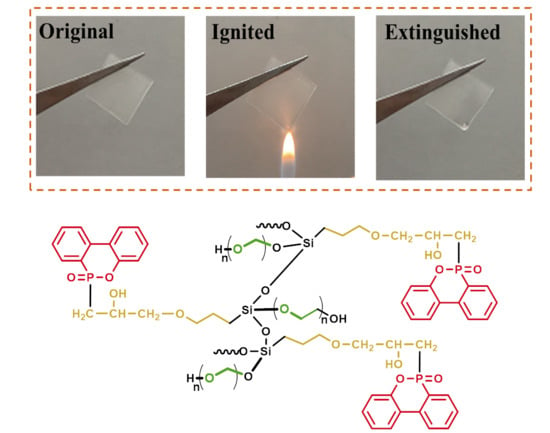A Novel Silicon/Phosphorus Co-Flame Retardant Polymer Electrolyte for High-Safety All-Solid-State Lithium Ion Batteries
Abstract
1. Introduction
2. Experiment
2.1. Materials
2.2. Samples Preparation
2.2.1. Preparation of DOPO-KH560-PEG600 Polymer
2.2.2. Preparation of DOPO-KH560-PEG600/LiTFSI Polymer Solid Electrolyte
2.2.3. Preparation of LiFePO4|DOPO-KH560-PEG600/LiTFSI|Li Battery
The Preparation of LiFePO4 Cathode
The Preparation of Button Lithium Ion Battery
2.3. Experimental Measurements
3. Results and Discussion
3.1. Characterization of the Structure and Thermal Properties of DKP Polymer
3.2. Combustion Analysis of DKP/LiTFSI Solid Electrolyte
3.3. Electrochemical Performance of DKP/LiTFSI Solid Electrolyte
4. Conclusions
Author Contributions
Funding
Conflicts of Interest
References
- Goodenough, J.B.; Park, K.-S. The Li-ion rechargeable battery: A perspective. J. Am. Chem. Soc. 2013, 135, 1167–1176. [Google Scholar] [CrossRef] [PubMed]
- Kajari, C.; Pathak, A.D.; Avinash, L.; Sharma, C.S.; Kumar, S.K.; Singh, K.A. Synthesis, characterization and application of a non-flammable dicationic ionic liquid in lithium-ion battery as electrolyte additive. Sci. Rep. 2020, 10, 1–14. [Google Scholar]
- Xu, J.; Wang, X.; Yuan, N.; Hu, B.; Ding, J.; Ge, S. Graphite-based lithium ion battery with ultrafast charging and discharging and excellent low temperature performance. J. Power Sources 2019, 430, 74–79. [Google Scholar] [CrossRef]
- Wei, Z.; Zhao, D.; He, H.; Cao, W.; Dong, G. A noise-tolerant model parameterization method for lithium-ion battery management system. Appl. Energy. 2020, 268, 114932. [Google Scholar] [CrossRef]
- Wei, Z.; Zhao, J.; Ji, D.; Tseng, K.J. A multi-timescale estimator for battery state of charge and capacity dual estimation based on an online identified model. Appl. Energy 2017, 204, 1264–1274. [Google Scholar] [CrossRef]
- Wang, Q.; Jiang, L.; Yu, Y.; Sun, J.J.N.E. Progress of enhancing the safety of lithium ion battery from the electrolyte aspect. Nano Energy 2019, 55, 93–114. [Google Scholar] [CrossRef]
- Lyu, P.; Liu, X.; Qu, J.; Zhao, J.; Huo, Y.; Qu, Z.; Rao, Z. Recent advances of thermal safety of lithium ion battery for energy storage. Energy Storage Mater. 2020, 31, 195–220. [Google Scholar] [CrossRef]
- Liu, K.; Liu, Y.; Lin, D.; Pei, A.; Cui, Y. Materials for lithium-ion battery safety. Sci. Adv. 2018, 4, 1–11. [Google Scholar] [CrossRef]
- Noelle, D.J.; Wang, M.; Le, A.V.; Shi, Y.; Qiao, Y. Internal resistance and polarization dynamics of lithium-ion batteries upon internal shorting. Appl. Energy 2018, 212, 796–808. [Google Scholar]
- Liu, B.; Jia, Y.; Li, J.; Yin, S.; Yuan, C.; Hu, Z.; Wang, L.; Li, Y.; Xu, J. Safety issues caused by internal short circuits in lithium-ion batteries. J. Mater. Chem. A 2018, 6, 21475–21484. [Google Scholar] [CrossRef]
- Deng, J.; Bae, C.; Marcicki, J.; Masias, A.; Miller, T. Safety modelling and testing of lithium-ion batteries in electrified vehicles. Nat. Energy 2018, 3, 261–266. [Google Scholar] [CrossRef]
- Zhu, J.; Wierzbicki, T.; Li, W. A review of safety-focused mechanical modeling of commercial lithium-ion batteries. J. Power Sources 2018, 378, 153–168. [Google Scholar] [CrossRef]
- Zhang, Q.; Liu, K.; Ding, F.; Liu, X. Recent advances in solid polymer electrolytes for lithium batteries. Nano Res. 2017, 10, 4139–4174. [Google Scholar] [CrossRef]
- Ehteshami, N.; Ibing, L.; Stolz, L.; Winter, M.; Paillard, E. Ethylene carbonate-free electrolytes for Li-ion battery: Study of the solid electrolyte interphases formed on graphite anodes. J. Power Sources 2020, 451, 227804–227816. [Google Scholar] [CrossRef]
- Li, J.; Lin, Y.; Yao, H.; Yuan, C.; Liu, J. Tuning Thin-Film Electrolyte for Lithium Battery by Grafting Cyclic Carbonate and Combed Poly (ethylene oxide) on Polysiloxane. ChemSusChem 2014, 7, 1901–1908. [Google Scholar] [CrossRef]
- Lin, Y.; Li, J.; Lai, Y.; Yuan, C.; Cheng, Y.; Liu, J. A wider temperature range polymer electrolyte for all-solid-state lithium ion batteries. RSC Adv. 2013, 3, 10722–10730. [Google Scholar] [CrossRef]
- Henriksen, M.; Vågsæther, K.; Lundberg, J.; Forseth, S.; Bjerketvedt, D. Explosion characteristics for Li-ion battery electrolytes at elevated temperatures. J. Hazard. Mater. 2019, 371, 1–7. [Google Scholar] [CrossRef]
- Zhang, Z.; Fang, S. Novel network polymer electrolytes based on polysiloxane with internal plasticizer. Electrochim. Acta 2000, 45, 2131–2138. [Google Scholar] [CrossRef]
- Fu, J.; Lu, Q.; Shang, D.; Chen, L.; Jiang, Y.; Xu, Y.; Yin, J.; Dong, X.; Deng, W.; Yuan, S. A novel room temperature POSS ionic liquid-based solid polymer electrolyte. J. Mater. Sci. 2018, 53, 8420–8435. [Google Scholar] [CrossRef]
- Falco, M.; Simari, C.; Ferrara, C.; Nair, J.R.; Meligrana, G.; Bella, F.; Nicotera, I.; Mustarelli, P.; Winter, M.; Gerbaldi, C. Understanding the effect of UV-induced cross-linking on the physicochemical properties of highly performing PEO/LiTFSI-based polymer electrolytes. Langmuir 2019, 35, 8210–8219. [Google Scholar] [CrossRef]
- Chen, G.; Zhang, K.; Liu, Y.; Ye, L.; Gao, Y.; Lin, W.; Xu, H.; Wang, X.; Bai, Y.; Wu, C. Flame-retardant gel polymer electrolyte and interface for quasi-solid-state sodium ion batteries. Chem. Eng. J. 2020, 401, 126065. [Google Scholar] [CrossRef]
- Noor, S.A.M.; Howlett, P.C.; MacFarlane, D.R.; Forsyth, M. Properties of sodium-based ionic liquid electrolytes for sodium secondary battery applications. Electrochim. Acta 2013, 114, 766–771. [Google Scholar] [CrossRef]
- Shaplov, A.S.; Marcilla, R.; Mecerreyes, D. Recent advances in innovative polymer electrolytes based on poly (ionic liquid) s. Electrochim. Acta 2015, 175, 18–34. [Google Scholar] [CrossRef]
- Zou, X.; Lu, Q.; Zhong, Y.; Liao, K.; Zhou, W.; Shao, Z. Flexible, Flame-Resistant, and Dendrite-Impermeable Gel-Polymer Electrolyte for Li–O2/Air Batteries Workable Under Hurdle Conditions. Small 2018, 14, 1801798. [Google Scholar] [CrossRef] [PubMed]
- Jiang, P.; Zhang, S.; Bourbigot, S.; Chen, Z.; Duquesne, S.; Casetta, M. Surface grafting of sepiolite with a phosphaphenanthrene derivative and its flame-retardant mechanism on PLA nanocomposites. Polym. Degrad. Stab. 2019, 165, 68–79. [Google Scholar] [CrossRef]
- Zheng, N.; Wu, D.; Sun, P.; Liu, H.; Luo, B.; Li, L. Mechanical Properties and Fire Resistance of Magnesium-Cemented Poplar Particleboard. Materials 2019, 12, 3161. [Google Scholar] [CrossRef]
- Wu, C.S.; Liu, Y.L.; Chiu, Y.S. Epoxy resins possessing flame retardant elements from silicon incorporated epoxy compounds cured with phosphorus or nitrogen containing curing agents. Polymer 2002, 43, 4277–4284. [Google Scholar] [CrossRef]
- Han, P.; Zhu, Y.; Liu, J. An all-solid-state lithium ion battery electrolyte membrane fabricated by hot-pressing method. J. Power Sources 2015, 284, 459–465. [Google Scholar] [CrossRef]
- Zhao, F.; Qian, X.; Gu, N.; Dong, S. Calculation of conductivity of polymer electrolyte by imaginary part of impedance. Anal. Chem. 2002, 30, 1153–1157. [Google Scholar]
- Wang, Q.; Xiong, L.; Liang, H.; Chen, L.; Huang, S.; Lian, Z.J.I. Synthesis and characterization of a novel polyhedral oligomeric silsesquioxanes containing phosphorus and boron. Inorg. Nano-Metal. Chem. 2017, 47, 99–104. [Google Scholar]
- Papke, B.; Ratner, M.; Shriver, D.J.J.o.P. Synthesis and characterization of a novel polyhedral oligomeric silsesquioxanes containing phosphorus and boron. J. Phys. Chem. Solids 1981, 42, 493–500. [Google Scholar] [CrossRef]
- Kolhe, P.; Kannan, R.M. Improvement in ductility of chitosan through blending and copolymerization with PEG: FTIR investigation of molecular interactions. Biomacromolecules 2003, 4, 173–180. [Google Scholar] [CrossRef] [PubMed]
- Xu, G.; Shi, T.; Wang, Q.; Liu, J.; Yi, Y. A facile way to prepare two novel DOPO-containing liquid benzoxazines and their graphene oxide composite. J. Appl. Polym. Sci. 2015, 132, 41634–41645. [Google Scholar] [CrossRef]
- Li, Y.; Zhan, H.; Wu, L.; Li, Z.; Zhou, Y. Flame-retarding ability and electrochemical performance of PEO-based polymer electrolyte with middle MW cyclic phosphate. Solid State Ion. 2006, 177, 1179–1183. [Google Scholar] [CrossRef]
- Shibutani, R.; Tsutsumi, H.; Shibutani, R.; Tsutsumi, H. Fire-retardant solid polymer electrolyte films prepared from oxetane derivative with dimethyl phosphate ester group. J. Power Sources 2012, 202, 369–373. [Google Scholar] [CrossRef]
- Saw, L.H.; Poon, H.M.; Thiam, H.S.; Cai, Z.; Chong, W.T.; Pambudi, N.A.; King, Y.J.J.A.e. Novel thermal management system using mist cooling for lithium-ion battery packs. Appl. Energy 2018, 223, 146–158. [Google Scholar] [CrossRef]
- Bouchet, R.; Maria, S.; Meziane, R.; Aboulaich, A.; Lienafa, L.; Bonnet, J.-P.; Phan, T.N.; Bertin, D.; Gigmes, D.; Devaux, D.; et al. Single-ion BAB triblock copolymers as highly efficient electrolytes for lithium-metal batteries. Nat. Mater. 2013, 12, 452–457. [Google Scholar] [CrossRef]
- Zhang, J.; Yue, L.; Hu, P.; Liu, Z.; Qin, B.; Zhang, B.; Wang, Q.; Ding, G.; Zhang, C.; Zhou, X. Taichi-inspired rigid-flexible coupling cellulose-supported solid polymer electrolyte for high-performance lithium batteries. Sci. Rep. 2014, 4, 1–7. [Google Scholar] [CrossRef]
- Liu, X.; Zhang, C.; Gao, S.; Cai, S.; Wang, Q.; Liu, J.; Liu, Z. A novel polyphosphonate flame-retardant additive towards safety-reinforced all-solid-state polymer electrolyte. Mater. Chem. Phys. 2020, 239, 122014. [Google Scholar] [CrossRef]
- Nair, J.R.; Cíntora-Juárez, D.; Pérez-Vicente, C.; Tirado, J.L.; Ahmad, S.; Gerbaldi, C. Truly quasi-solid-state lithium cells utilizing carbonate free polymer electrolytes on engineered LiFePO4. Electrochim. Acta 2016, 199, 172–179. [Google Scholar] [CrossRef]
- Zhao, L.; Fu, J.; Du, Z.; Jia, X.; Qu, Y.; Yu, F.; Du, J.; Chen, Y. High-strength and flexible cellulose/PEG based gel polymer electrolyte with high performance for lithium ion batteries. J. Membr. Sci. 2020, 593, 117428. [Google Scholar] [CrossRef]
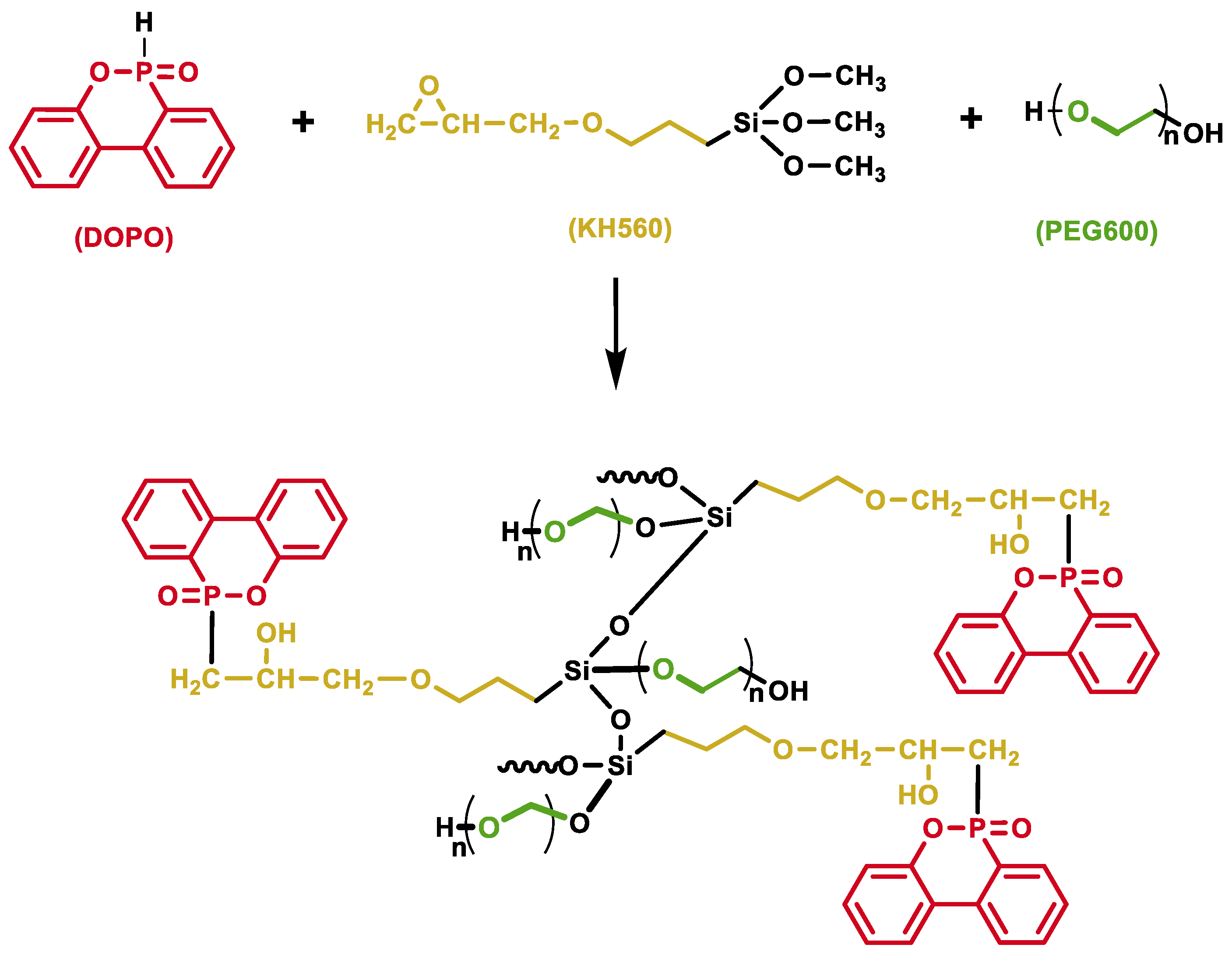
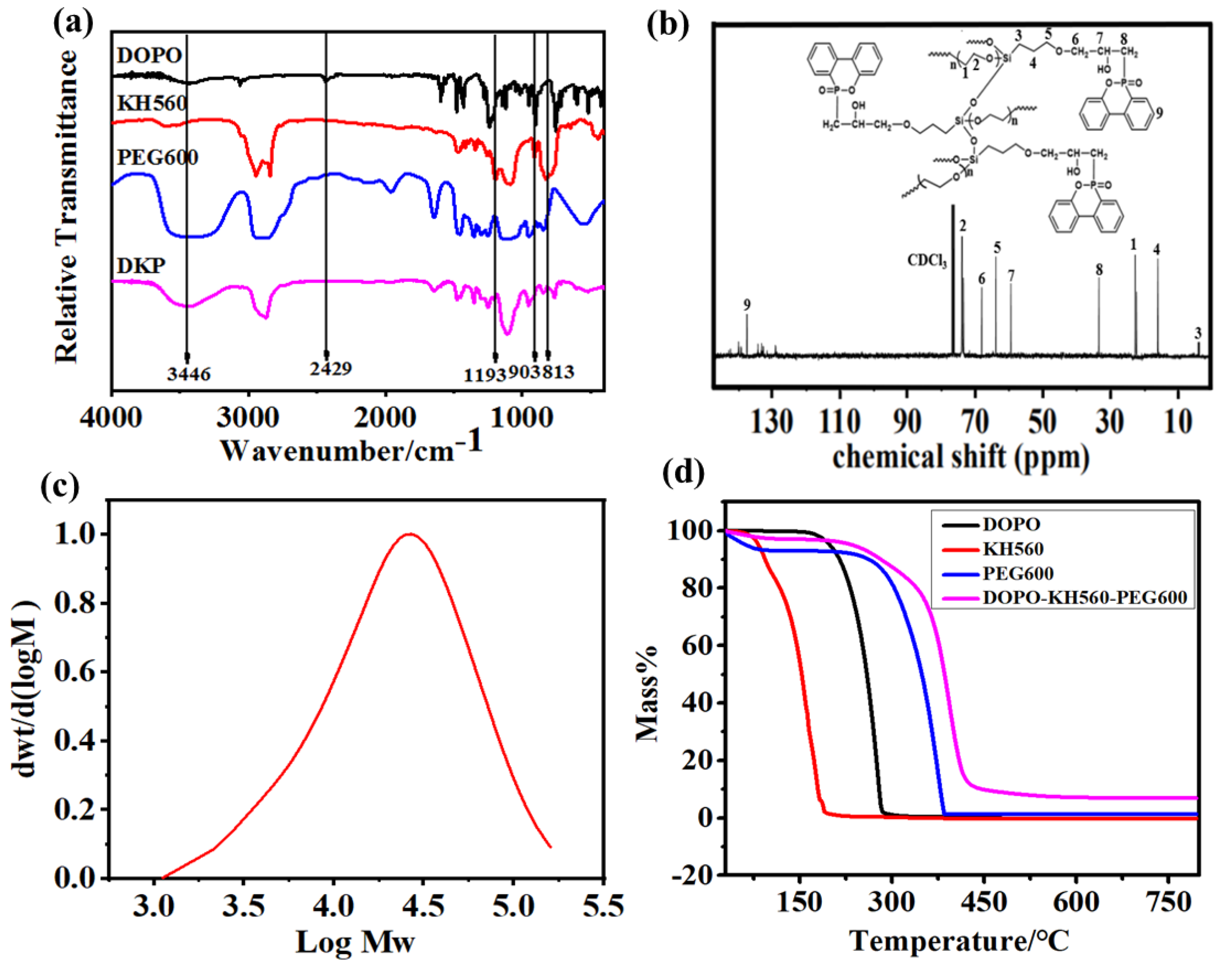
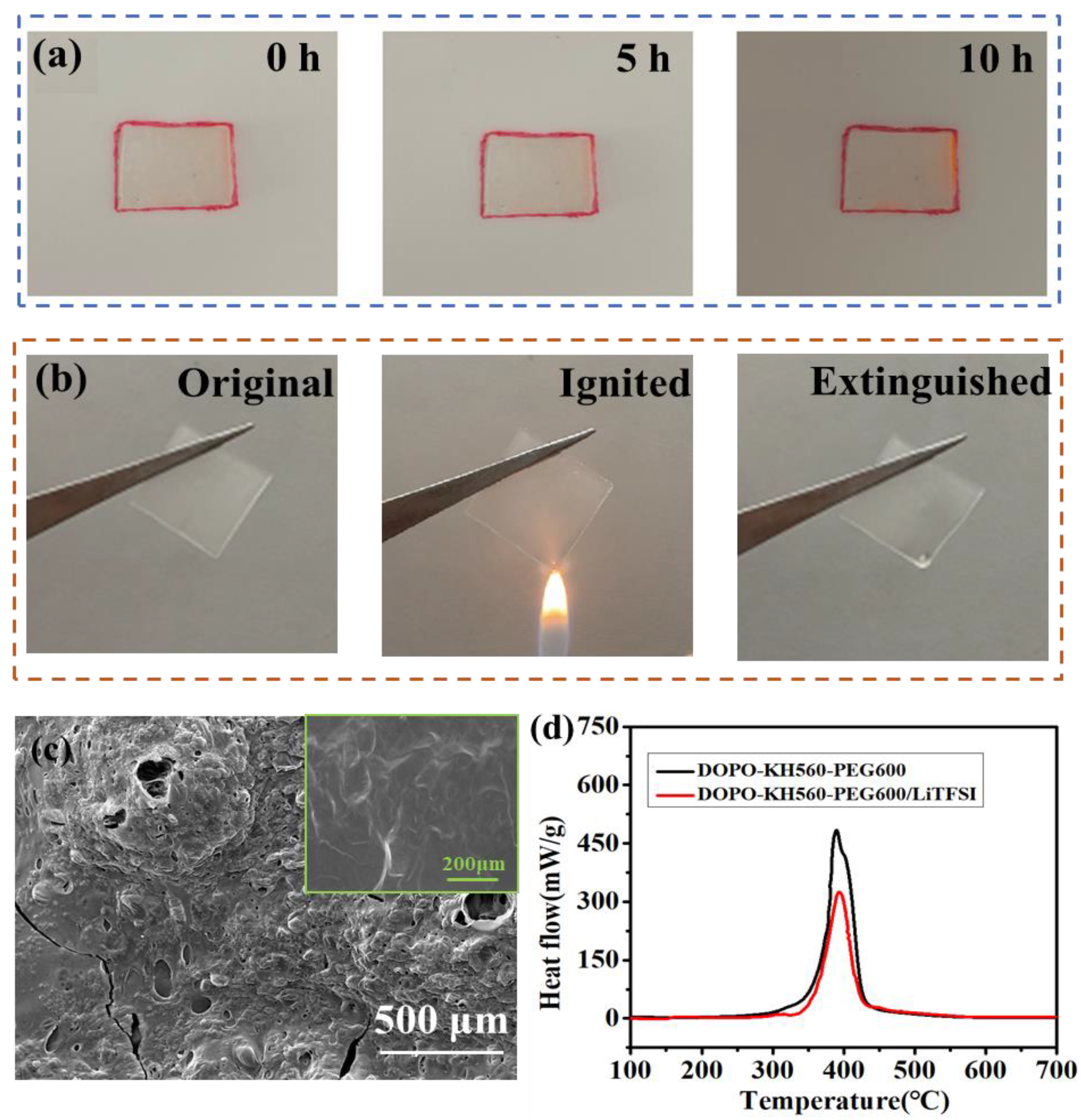
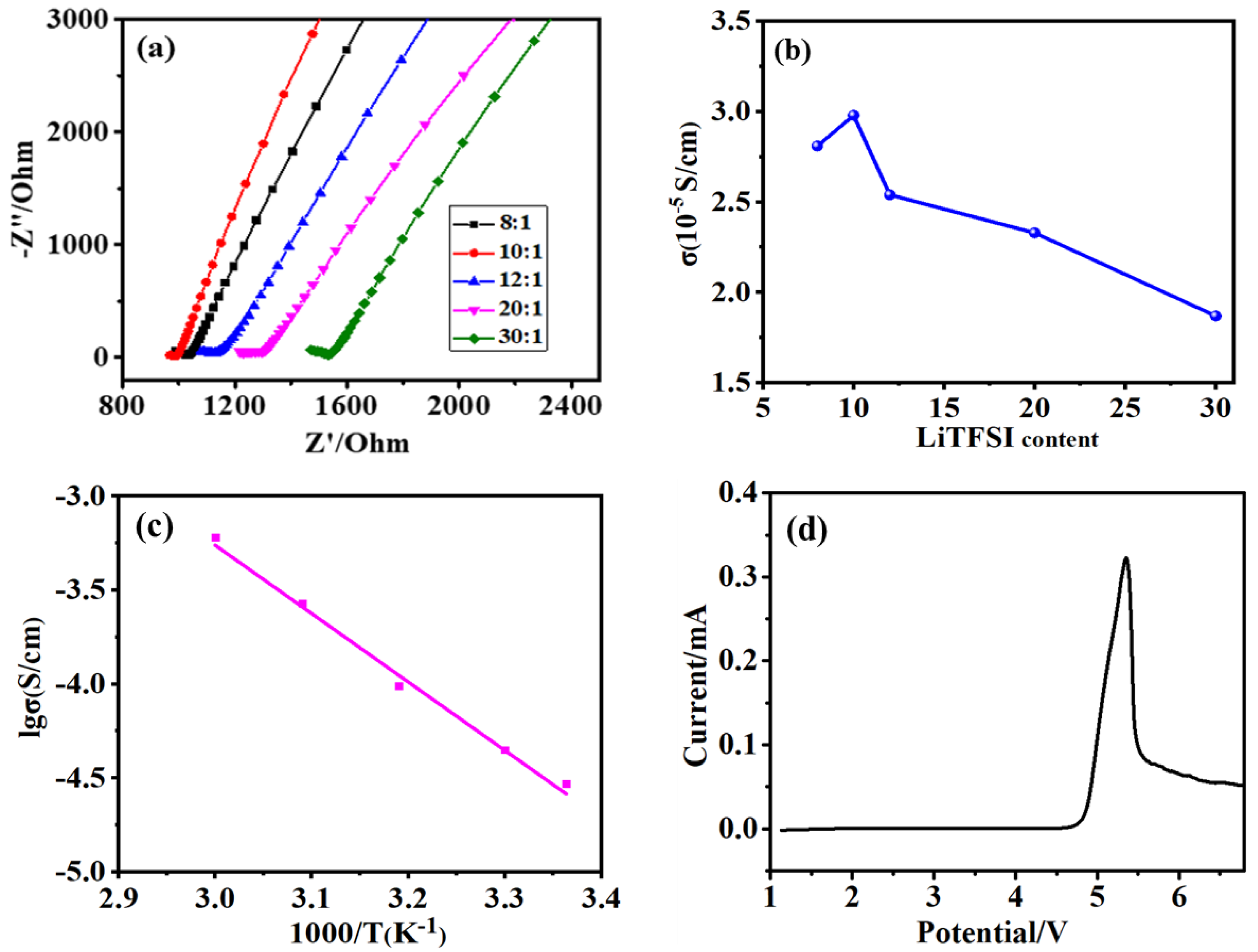
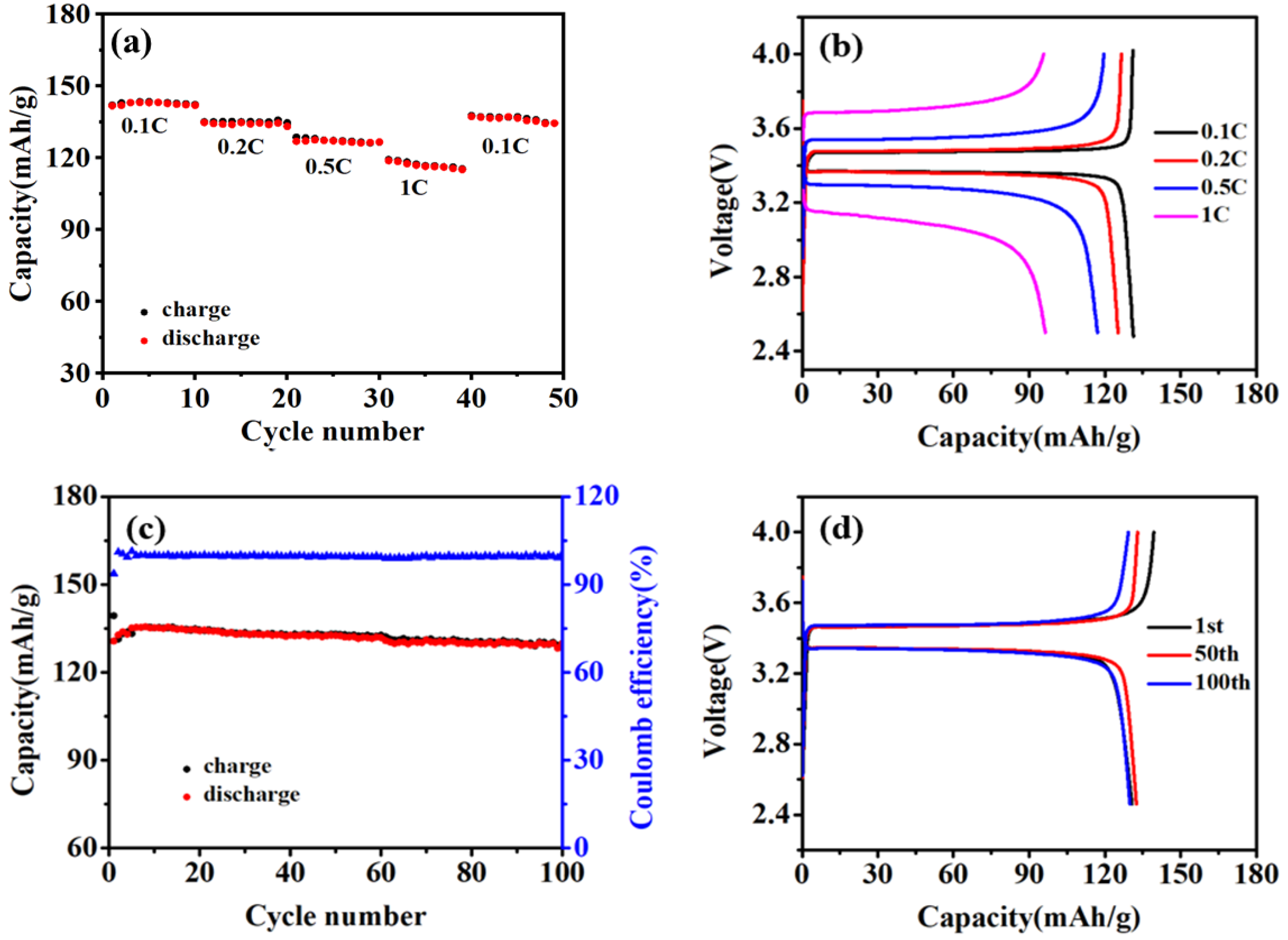
| Cell | Capacity (mAh/g) | Temp (°C) | Ionic Conductivity (S/cm) | Ref |
|---|---|---|---|---|
| Cellulose-PEO-PCA-LiBOB (LiFePO4/Li) | 150 at 0.07 C 138 at 2 C | 60 | 1.3 × 10−5 | [37] |
| P(STFSILi)-PEO-P(STFSILi) (LiFePO4/Li) | 153 at 0.1 C 118 at 1 C | 60 | 3 × 10−4 | [38] |
| PEO/DPMB-LiTFSI (LiFePO4/Li) | 150 at 0.02 C | 55 | 4.7 × 10−5 | [39] |
| BDM-PDG-LiTFSI (LiFePO4/Li) | 140 at 0.1 C 35 at 1 C | 70 | 6.5 × 10−4 | [40] |
| cellulose/PEG LiTFSI (LiFePO4/Li) | 153.3 at 0.2 C 97 at 1 C | 55 | 6.1 × 10−3 | [41] |
| DKP-LiTFSI (LiFePO4/Li) | 142.0 at 0.1 C 115.5 at 1 C | 60 | 5.96 × 10−4 | This work |
Publisher’s Note: MDPI stays neutral with regard to jurisdictional claims in published maps and institutional affiliations. |
© 2020 by the authors. Licensee MDPI, Basel, Switzerland. This article is an open access article distributed under the terms and conditions of the Creative Commons Attribution (CC BY) license (http://creativecommons.org/licenses/by/4.0/).
Share and Cite
Zeng, L.; Jia, L.; Liu, X.; Zhang, C. A Novel Silicon/Phosphorus Co-Flame Retardant Polymer Electrolyte for High-Safety All-Solid-State Lithium Ion Batteries. Polymers 2020, 12, 2937. https://doi.org/10.3390/polym12122937
Zeng L, Jia L, Liu X, Zhang C. A Novel Silicon/Phosphorus Co-Flame Retardant Polymer Electrolyte for High-Safety All-Solid-State Lithium Ion Batteries. Polymers. 2020; 12(12):2937. https://doi.org/10.3390/polym12122937
Chicago/Turabian StyleZeng, Li, Lu Jia, Xingang Liu, and Chuhong Zhang. 2020. "A Novel Silicon/Phosphorus Co-Flame Retardant Polymer Electrolyte for High-Safety All-Solid-State Lithium Ion Batteries" Polymers 12, no. 12: 2937. https://doi.org/10.3390/polym12122937
APA StyleZeng, L., Jia, L., Liu, X., & Zhang, C. (2020). A Novel Silicon/Phosphorus Co-Flame Retardant Polymer Electrolyte for High-Safety All-Solid-State Lithium Ion Batteries. Polymers, 12(12), 2937. https://doi.org/10.3390/polym12122937




